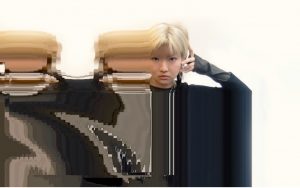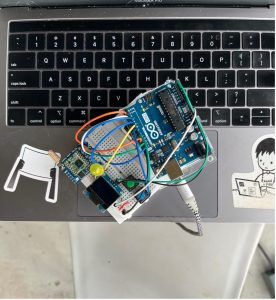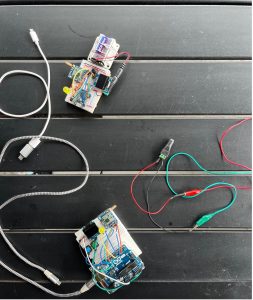
Image courtesy of Viola He
The affordances, limitations, and architectures of space, proximity, interaction, and playfulness come together through unlikely radio frequencies in the experimental works of Shanghai-born, New York City-based interdisciplinary artist Viola He’s recent creative experiments.
While an artist-in-residence at Wave Farm—working from a studio space situated on a 29-acre property in the northern Catskills of upstate NY—He was inspired by LoRa, or Long-Range, signals and LoRaWAN network protocols. These are modest, low-power communication pathways that use open-source technology to transmit data over unlicensed frequency bands. They’re designed for Internet of Things (IoT) applications, small wireless networks that allow everyday objects—smartphones, wearables, vehicles, instruments, and more—to communicate. These frequencies are decentralized, somewhat precarious, invisible, and semi-public: open to anyone who knows they exist and has a desire to tap into them.
He does just that and appropriates this technology to use it in a creative capacity, instead using alternative networks that operate outside of the official channels of communication, such as the WiFi that binds our smartphones, tablets, and personal computers. Secondary frequencies are nearly private, low-power stages for minor signals to flow, and are thus a respite from the hectic buzz, traffic, and distance characterized by the internet.
LoRas, like every type of communication channel, transmit data. But in He’s experiments, the data isn’t verbal or image-based or strictly sonic. It manifests as actions: a vibration, a playful wiggle, a subtle gesture, all tied to the participants’ movements, 3D-printed wearables designed by He, and other constructed objects that are ready to send and receive signals. Transmission is also subject to interference from anything that might obstruct the path of the signal: an architectural structure, a spike in elevation, excessive distance. By using these alternative networks, He works with these limitations—the possibility of a lost or failed signal—as part of the experience. Further, she is reconstituting the body, making it a necessary node of communication through the participant’s movement, physical location and spatial orientation. In this way, communication hangs on at the margins: contact between participants isn’t a given. It’s relational and inexact.
His devices are designed to indicate signal strength and rotational information, allowing approximate indications of distance and movements between communicating parties, never exact locations or specific movements. He describes it as a kind of “ambient poetic communication, like having the presence of someone” without the creepy, controlling protocols of surveillance technologies, which run rampant across our connected devices and public spaces. With this in mind, He isn’t interested in recording or storing the exchanged data. The actions between participants are thus ephemeral and performative. Participants have the benefit and assurance of remote connection with someone transmitted to them by a subtle signal, indicating the bodily presence of another in the distance. Together, they create a choreography of signals being written in real-time by their movements and participation with one another in an ongoing, mutable score.

Prototype image, courtesy of the author.

Prototype image, courtesy of the author.
These qualities of creating through adaptation and variation, what He refers to as “structured improvisation”, illustrate their multidisciplinary approach to thinking and making. He’s work combines software, hardware, and wetware with equal measure, drawing on their educational background in communications theory and practice, experience as a dancer, and their live coding music performances, which they describe as the opportunity to “wield technology in a way that [uses] whatever is available and whatever is comfortable [to use] as an instrument.” This is the DIY philosophy and approach they use to make their LoRa devices, which comprise a mix of high and low technologies. LoRa modules, and transmitter and receiver boards are combined with fabric, thread, glue, wires, and alkaline batteries. One wearable device is a 3D-printed helmet with a cyberpunk aesthetic.
The use of alternative networks is a radical starting point for challenging dominant networks and the platform Capitalism they impose on users, verging on tactical media. As we find ourselves increasingly stuck on the platform1, as Geert Lovink argues, the need for secondary networks of communication—which circumvent centralized services that are controlled, surveilled, and sometimes shut down by tech providers or authorities—is imperative. Moreover, they offer new ways of engaging one another without the messy and exhausting but aggressively seductive tug and subsequent fallout of Zoom fatigue, social media self-promotion, cancel culture toxicity, and the cyclical trap of doomscrolling. Dominated by social media, today’s internet is addictive by design: endlessly feeding the compulsion to click, refresh, and share in search of novelty and strengthening social currency. We are, as Wendy Chun writes, “forever trying to catch up, updating to remain (close to) the same; bored, overwhelmed, and anxious all at once.”2 Lovink argues that these addictive behaviours have led to a kind of platform nihilism, a robust pessimism suggesting any hope for alternatives to this prevailing design is lost. But even this can change. “Code is shaping our world, and its architecture is voluntary and plastic.”3
Artists like He creates small-scale artistic interventions that encourage a temporary hiatus from the platform grind. They offer a fresh perspective on what it means to engage socially, to use our bodies without datafication and yielding to the platform’s selfish design. They help us (re)discover our senses by using radio frequencies that reach beyond the expectations of sound on the radio and the visual dominance of the web. We can experience the feeling of being present in the world, physically and psychically, and connect with others in ways that are truly novel. It’s possible such experiments can inspire new ways of designing our web experiences: without the social pressures of popularity and social media metrics, rather through the nuanced assurance of presence through subtle gestures.
—
NOTES
1 Geert Lovink, Stuck on the Platform: Reclaiming the Internet (Amsterdam: Valiz, 2022).
2 Wendy Hui Kyong Chun, Updating to Remain the Same: Habitual New Media (Cambridge: The MIT Press, 2017), 1.
3 Geert Lovink, Sadness by Design: On Platform Nihilism (London: Pluto Press, 2019), 139.
All quotes from Viola He are taken from a recorded conversation between He, the author, and Justin Maiman, host of Ginger Radio Hour, a bi-monthly show on Wave Farm’s WGXC-FM listener-supported radio station. The conversation was recorded at WGXC’s studio on 28 August 2023 and archived here.
—
Natasha Chuk is a media theorist, arts writer, and independent curator whose research and interests focus on creative technologies as systems of language at the intersection of expression, interface, and perception. She lives and works in New York City.


